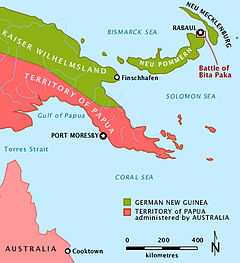Australian occupation of German New Guinea
| ||||||||||||||||||||||
The Australian occupation of German New Guinea was the takeover of the Pacific colony of German New Guinea in September – November 1914 by an expeditionary force from Australia, called the Australian Naval and Military Expeditionary Force.
Background
Geography
German New Guinea (German: Deutsch-Neuguinea) was a German protectorate from 1884. German New Guinea consisted of the territories of the northeastern part of New Guinea (German: Kaiser-Wilhelmsland) and the nearby Bismarck Archipelago, consisting of New Britain (German: Neu-Pommern) and New Ireland (German: Neu-Mecklenburg).[1] Together with the other Western Pacific German islands, excluding German Samoa, they formed the Imperial German Pacific Protectorates. The protectorate included the German Solomon Islands, the Caroline Islands, Palau, the Mariana Islands (except for Guam), the Marshall Islands and Nauru.[2]
Military situation
Following the outbreak of World War I, the German East Asia Squadron, consisting of the armored cruisers Scharnhorst and Gneisenau and the light cruisers Nürnberg, Leipzig, Dresden and Emden, under the command of Vice-Admiral Maximilian von Spee, was cruising in the Pacific Ocean. The threat posed by the German squadron, caused concerns regarding attacks on merchant shipping in the region. The German wireless stations and coaling stations in the Pacific were to be destroyed after a request from Great Britain. Great Britain had previously severed all German undersea cables routed through British controlled areas.
Prelude
Australia
Australia hurriedly raised the Australian Naval & Military Expeditionary Force (ANMEF), consisting of 1000 soldiers and 500 sailors. The ANMEF was tasked with the capture of the Imperial German Pacific Protectorates within six months. This included capturing or destroying the radio stations and coal stations supporting the German East Asia Squadron. The AN&MEF comprised one battalion of infantry of 1,000 men enlisted in Sydney, known as the 1st Battalion, ANMEF and 500 naval reservists and ex-sailors who would serve as infantry.[3] Another battalion of militia from the Queensland based Kennedy Regiment, which had been hurriedly dispatched to garrison Thursday Island, also contributed 500 volunteers to the force.[4]
A reconnaissance of the area was undertaken by the Australia Squadron, consisting of the battlecruiser HMAS Australia, the second class protected cruiser HMAS Encounter, the light cruisers HMAS Melbourne and Sydney and the destroyers HMAS Parramatta, Yarra, and Warrego, under the command of Vice Admiral Sir George Patey, entered Blanche Bay on 12 August. The destroyers entered Simpson Harbour and Matupi Harbour at night searching for the German East Asia Squadron. Landing parties from the destroyers were sent ashore to demolish the telephones in the post offices in Rabaul and at the German gubernatorial capital of Herbertshöhe (now Kokopo), located 20 miles (32 km) to the south-east. Intelligence was sort about the location of the radio station, although no information was forthcoming. After threatening to bombard the nearby settlements if the radio station continued to transmit, the Australian warships withdrew.[5] HMAS Australia captured Sumatra and HMAS Encounter captured Zambesi whilst patrolling St Georges Channel on 12 August. HMAS Melbourne requisitioned the cargo of coal of the collier Alconda off Rossel Island on 13 August.
German New Guinea
The Germans had a force of Polizeitruppe, typically used for putting down rebellions. At Bita Paka, the Polizeitruppe comprised approximately 50 German officers and 240 native police soldiers. Rabaul was well stocked with the coal for use by the German East Asian Cruiser Squadron.
Occupation
New Britain
Battle of Bita Paka

The Battle of Bita Paka was fought on 11 September 1914, to capture the wireless station at Bita Paka. A mixed force of German officers and Melanesian police mounted a stout resistance and forced the Australians to fight their way to the objective. However, after a day of fighting during which both sides suffered casualties, the Australian forces captured the wireless station.[6]
Siege of Toma
The Siege of Toma was a siege between 14–17 September 1914 after troops of the ANMEF surrounded Toma, preceding to bombard it with a 12 pound field piece, which caused the Germans to negotiate a surrender.[7]
New Guinea
Madang
Madang was captured without opposition on 24 September 1914.
Aftermath
Lieutenant Hermann Detzner, a German officer, and some 20 native police evaded capture in the interior of New Guinea for the entire war. After the Treaty of Versailles of 1919, Germany lost all its colonial possessions, including German New Guinea, which became the Territory of New Guinea, a League of Nations Mandate Territory under Australian administration.
See also
Notes
- ↑ Churchill 1920, p. 84.
- ↑ MacKenzie 1941, pp. 1–6.
- ↑ Grey 2008, p. 87.
- ↑ MacKenzie 1941, pp. 23–25.
- ↑ MacKenzie 1941, p. 38.
- ↑ Clark 2010, pp. 96–97.
- ↑ Odgers 1994, p. 42.
References
- Churchill, William (1920). "Germany's Lost Pacific Empire". Geographical Review (Oxford: Wiley-Blackwell). Volume X (No. 2): 84–90. ISSN 0016-7428.
- Clark, Chris (2010). The Encyclopaedia of Australia's Battles (3rd ed.). Crows Nest, New South Wales: Allen and Unwin. ISBN 1742373356.
- Grey, Jeffrey (2008). A Military History of Australia (3rd ed.). Melbourne: Cambridge University Press. ISBN 978-0-521-69791-0.
- MacKenzie, Seaforth (1941). The Australians at Rabaul: The Capture and Administration of the German Possessions in the South Pacific. Official History of Australia in the War of 1914–1918, Volume X. (Tenth ed.). Canberra, Australian Capital Territory: Australian War Memorial. OCLC 494426919.
- Odgers, George (1994). 100 Years of Australians at War. Sydney: Lansdowne. ISBN 1-86302-669-X.
.jpg)